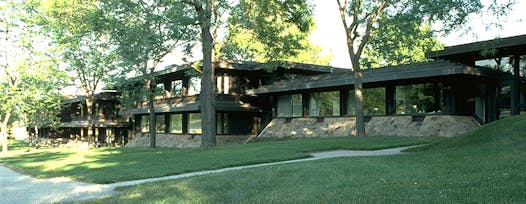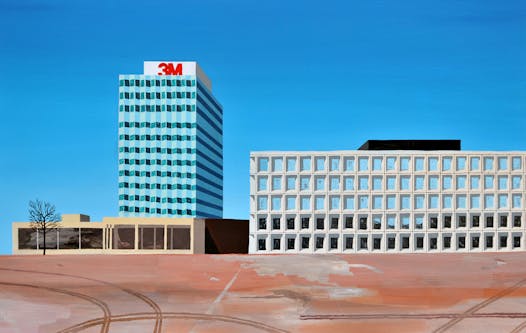The postwar suburbs of the Twin Cities are home to a remarkable collection of modern architecture.
Some are high-style synagogues, churches and corporate centers — like the landmark General Mills headquarters in Golden Valley designed by celebrated Chicago architects Skidmore, Owings & Merrill.
But most are humble, practical buildings, such as gas stations, dry cleaning shops and fast-food franchises, which often change with the demands of marketing.
Most of our old Dairy Queens, branch banks and pioneering suburban shopping centers (think Knollwood Plaza in St. Louis Park) are gone or altered beyond recognition. They were the victims of the "tween" years in the nostalgia-laden 1980s and 1990s, when modernism seemed stiff and cold and modern buildings were renovated or torn down. But some glimpses of untouched modernism can still be found.
Hidden modern
One of our finest examples of commercial modernism is the former Midwest Federal bank on Hwy. 55 in Golden Valley. Now serving as a lighting store, this delicate round glass building is the lone survivor of several Midwest Federal branches designed by Miller-Dunwiddie in 1963.
After generations of fortresslike banks, these glass structures (which were built in Bloomington, Edina, Robbinsdale, Roseville and St. Louis Park) seemed quite daring. Some Twin Cities residents even expressed concern about the security of a bank made out of glass. But what could be more modern than a bright, circular pavilion that you could see inside — while all the cash could be secured safely underground?
Another building that took the same approach to modernism was Dairy Queen, which featured bold and simple forms, visible structural elements and welcoming transparency.
One of the oldest and most intact Dairy Queens in the country still operates in Roseville. Located at 1720 N. Lexington Av., this playful walk-up structure, which dates from 1947, features tall canted glass windows, a band of neon along the roofline and the classic rooftop Dairy Queen sign with cobalt blue background, neon letters and signature swirl ice cream cone.
Civic modernism
Many modern-era government centers, fire stations and libraries survive. Most unusual is the Crystal City Hall. Designed in 1964 by Zejdlik and Harmala Architects and built by local contractor Peterson-Templin, it is notable for its white facade with light metal window screens. The building looks a bit like a small Guggenheim Museum and merits preservation as a striking and unusual interpretation of modern design with curves.
It's worth a trip to Crystal to see City Hall as well as its next-door neighbor: the graceful, angled Rockford Road Library designed by Minnesotan Leonard Parker in 1972. A former member of Eero Saarinen's design office, Parker also designed one of the more exquisite examples of late modernism in the Twin Cities: the Eden Prairie corporate headquarters for Gelco Corp. Opened in the mid-1970s, the Gelco building has glass wings that step down into the hilly landscape in a rare combination of respect for site and boldness of form.
The Minneapolis Neurological Clinic in Golden Valley is another example of a talented Minnesota modernist at work. Designed by Bruce Abrahamson, a founder of HGA, the clinic's large picture windows, canted stone bases and flowing horizontal copper rooflines are tactile yet subdued. Though it was built in the late 1960s, it seems fresh and original today.
Leaving the city
For better or worse, corporate modernism was a product of urban flight. General Mills' mid-1950s move from downtown to the fields of Golden Valley reflected trends nationwide. The city of Minneapolis was so concerned about losing companies to the suburbs that it sold land in Wirth Park to keep the Prudential regional headquarters in the city.
Designed by the Minneapolis firm of Magney, Tusler and Setter (now Leo A. Daly), the 24-acre Prudential complex is really a suburban campus on the city's edge. Like the Rock of Gibraltar (Prudential's symbol), the tower conveys strength and permanence. It's an unusually heavy expression of modernism with Minnesota Kasota limestone, granite and punch-out square steel-framed windows.
Also in the mid-1950s, 3M commissioned St. Paul-based Ellerbe Architects to design a new headquarters campus in Maplewood after outgrowing its St. Paul facility. The brightly colored tower with angled window bays has long been a landmark on Interstate 94.
Though they were built for the long term, these corporate centers have been altered. General Mills has been added onto several times. The Prudential campus is currently for sale. Its desirable location on a parklike site makes it a tempting target for a new corporate campus, housing or mixed-use development.
Well-crafted corporate buildings such as Prudential are worth saving and re-using. Rarely do we build with such fine stone anymore. And re-use is a far greener solution than rebuilding on such a massive scale.
But even more modest modern buildings like the Roseville Dairy Queen and the last Midwest Federal can and should find new uses.
From branch libraries to glass banks, modern suburban buildings expressed an optimistic vision for the future. They still can.
Minneapolis writer Frank Edgerton Martin writes about urban design.




